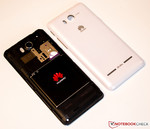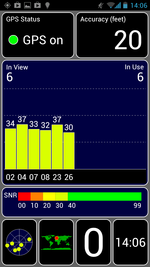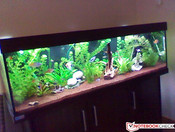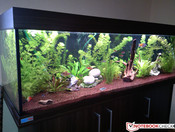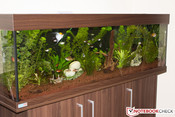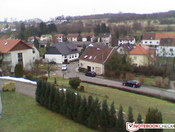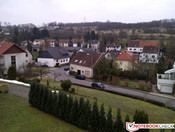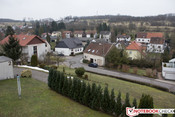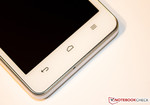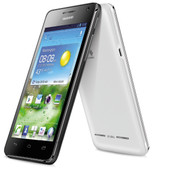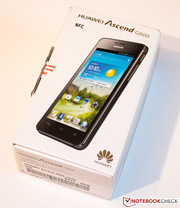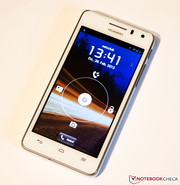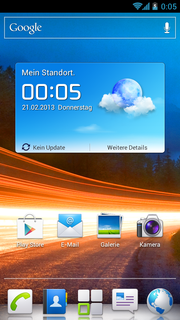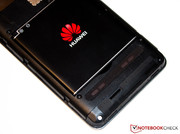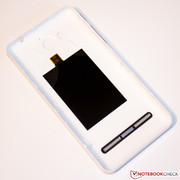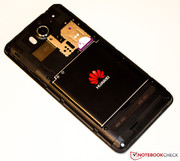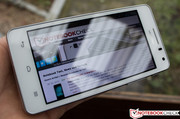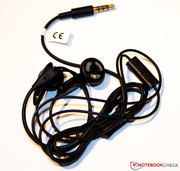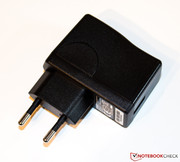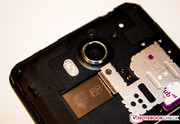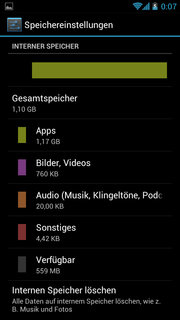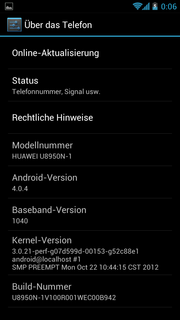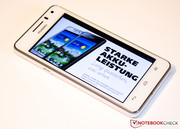Review Huawei Ascend G600 Smartphone

For the original German review, see here.
The Chinese manufacturer Huawei intends to increase their market share for both tablets and smartphones - at least that is what their ever-increasing portfolio of products seems to indicate. At the time of writing, Huawei is poised to launch five smartphones and is trying to push into the Windows Phone 8 market with the Ascend W1.
The Ascend G600 has been available for a few weeks now. On paper, the phone doesn't feature very exciting hardware components: the SoC - a 1.2 GHz Snapdragon S4 Play MSM8225 - is sourced from Qualcomm and has access to 768 MB of system RAM. The 4.5-inch display uses IPS technology and features a resolution of 960 x 540 pixels (gHD). Both the specs and the MSRP of 299 Euro (~$390) indicate that this is a middle-class phone. Whether or not the large smartphone is a worthy daily companion is the subject of our review.
Case
We reviewed the Huawei Ascend D1 Quad XL last December. The first time we handled the Ascend G600, we couldn't help but notice the striking similarities: both the form factor and the materials used differ only minimally. Like the D1 Quad XL, the G600 weighs in at 145 grams (5.11 ounces) - about 12 grams (0.42 ounces) more than the Samsung Galaxy S3. This result is a bit surprising, since the G600 is entirely made from plastic. Since the phone measures 134 x 67 x 11 millimeter (5.28 x 2.64 x 0.42 inches), it is actually neither light nor small.
The back of the phone is polycarbonate; the various control buttons are integrated into the cover. The display is surrounded by a matte chrome border, which is raised slightly to protect the screen against scratches. The build quality is pretty good: the phone resists twisting and pressure well. Only localized pressure in the middle of the display results in discolorations of the screen. The smooth back of the case could potentially be an issue, as the G600 easily slips out of the hand.
The smartphone is available in two colors: "mysterious black" and "pure white".
Connectivity
No surprises here. The right side is home to the power button and the rocker switch for the volume control right underneath. On the other side, a Micro-USB port is provided to charge the phone or connect it to a computer. The 3.5 millimeter jack on the top can be used for headphones or external speakers. The back cover hides the spot for the SIM card (standard size) and the MicroSD card reader, which allows the storage to be increased by up to 32 GB.
Communication & GPS
The Ascend G600 supports all current standards and also features an NFC module - typical for this price class. LTE functionality is not provided, but UMTS allows for a maximum connection speed of 7.2 Mbit/s. The WLAN module supports standards 802.11 b/g/n, Bluetooth 3.0 is also available. DLNA allows the user to share digital media across compliant devices.
The aGPS module was able to acquire a signal even inside, although the accuracy suffered a bit. Outside, we got very accurate position information. We never experienced any disconnects or issues with any of the communication modules.
Software
Huawei is introducing their first Windows Phone with the upcoming Ascend W1 - which also means that their current phones feature an OS from Google. The G600 uses 4.0.4 (Ice Cream Sandwich) - not the most current version of the software. The user can only hope that Huawei is going to offer an update down the line.
The G600 comes with its own launcher, which allows for some level of customization - for example, a "power-savings mode" is one of the available options.
Cameras & Multimedia
The G600 features two cameras: the main camera on the back has a resolution of 8 MP and features an LED flash for low-light conditions. The spec sheet does not shed any light on what quality settings are used for video recordings. The camera software also allows the creation of HDR photos and panoramas. The front camera only features a 0.3 MP sensor and is primarily used as a webcam for video conferencing. The main camera has some issues inside under low-light conditions and pictures get slightly noisy. Since the sensor is small, the photos are quite a bit darker than the ones we took with our reference camera. The LED flash doesn't help a lot in those scenarios. Photos taken with the front camera are downright mediocre - not really surprising, since the resolution is so low. Outside, the 8 MB camera captures good pictures with enough detail and colors that seem accurate enough, albeit a bit washed out.
Accessories
Aside from the phone itself, the modular power adapter, the headset, and various pamphlets, nothing else is included in the box, which is not that unusual: even higher priced phones - like the iPhone 5 and the Galaxy S3 - don't come with a lot of accessories.
Warranty
The phone is covered by a standard 12 month warranty. In EU countries, electronics are automatically covered by a two-year warranty, so the buyer can always request repairs or replacement if the phone is faulty or does not work as advertised.
Input Devices & Operation
The capacitive TFT touchscreen works well and can recognize five fingers at the same time. Inputs are registered quickly and precisely, although we noticed slight micro-stutters during operation. Application also don't quite load instantaneously. Hopefully, Huawei can fix some of these performance issues with a software update.
One negative aspect of the virtual QWERTY keyboard is the fact that more than 50 percent of the display is hidden in landscape mode. There is also noticeable lag when turning the G600 90 degrees before the content catches up.
Display
The G600 has the same size display as the D1 Quad XL - it's a 4.5-inch TFT IPS touchscreen. This is where the similarities end, however. Our review model features a resolution of 960 x 540 pixels (qHD) with approximately 244 DPI. The more expensive D1 Quad XL has 326 DPI, and the Samsung Galaxy S2 Plus 217 DPI.
| |||||||||||||||||||||||||
Brightness Distribution: 85 %
Center on Battery: 259 cd/m²
Contrast: 835:1 (Black: 0.31 cd/m²)
We recorded a maximum display brightness of 259 cd/m² in the middle of the screen, and an average of 236.3 cd/m². The D1 Quad XL, which has a very bright display, reached 411.2 cd/m² and the HTC One SV managed 387.8 cd/m². While the Galaxy S2 Plus has a near perfect brightness distribution, our review model only manages 85 percent. Using the brightness and the black value (0.31 cd/m²), we can calculate the contrast of 835:1 (D1 Quad XL: 1010:1, Galaxy S2 Plus: ∞).
Although the screen of the Ascend G600 is sufficiently bright, outdoor usability is somewhat restricted - especially when the sun is out. The Galaxy S2 Plus has similar brightness levels, but uses a Super AMOLED Plus display, so the values can't be compared directly. Matters are complicated further by the fact that the G600 has a highly reflective glare-type screen, which makes its use outside difficult at times.
At increasingly shallow viewing angles, the display starts to darken significantly and the colors get washed out. All in all, the IPS screen does its job well, although there are displays on the market which use the same technology, but offer better viewing angle stability.
Performance
Huawei frequently uses their own hardware for their phones. The SoC in the D1 Quad XL, for example, is sourced from HiSilicon - a sister company. The G600 uses tried-and-tested hardware from Qualcomm in form of the Snapdragon S4 Play MSM 8225 - a dual-core CPU with a core frequency of 1.2 GHz. An Adreno 203 GPU, 768 MB RAM, and 4 GB of internal storage round out the hardware. Should the internal storage not be enough, more can be added using a MicroSD card (up to 32 GB).
To compare the performance of the phone to the competition, we first run synthetic benchmark tests. The Ascend G600 trails all other smartphones by a fair margin (up to 200 percent) - only when running Linpack, our review model does slightly better.
| GLBenchmark 2.5 | |
| Egypt HD Fixed Time (sort by value) | |
| Huawei Ascend G600 | |
| HTC One SV | |
| Samsung Galaxy S2 Plus | |
| Huawei Ascend D1 Quad XL | |
| 1920x1080 Egypt HD Offscreen Fixed Time (sort by value) | |
| Huawei Ascend G600 | |
| HTC One SV | |
| Samsung Galaxy S2 Plus | |
| Huawei Ascend D1 Quad XL | |
| AnTuTu v3 - Total Score (sort by value) | |
| Huawei Ascend G600 | |
| HTC One SV | |
| Samsung Galaxy S2 Plus | |
| NenaMark2 - --- (sort by value) | |
| Huawei Ascend G600 | |
| HTC One SV | |
| Samsung Galaxy S2 Plus | |
| Huawei Ascend D1 Quad XL | |
| Linpack Android / IOS | |
| Multi Thread (sort by value) | |
| Huawei Ascend G600 | |
| HTC One SV | |
| Samsung Galaxy S2 Plus | |
| Huawei Ascend D1 Quad XL | |
| Single Thread (sort by value) | |
| Huawei Ascend G600 | |
| HTC One SV | |
| Samsung Galaxy S2 Plus | |
| Huawei Ascend D1 Quad XL | |
The browser-based benchmark tests are - as the name implies - browser specific. The G600 uses the standard Android browser. Here the smartphone fares better than during the synthetic tests...but the tendency is still pretty clear: the G600 lags behind the competition.
| Google V8 Ver. 7 - Google V8 Ver. 7 Score (sort by value) | |
| Huawei Ascend G600 | |
| HTC One SV | |
| Samsung Galaxy S2 Plus | |
| Huawei Ascend D1 Quad XL | |
| Browsermark - --- (sort by value) | |
| Huawei Ascend G600 | |
| HTC One SV | |
| Samsung Galaxy S2 Plus | |
| Huawei Ascend D1 Quad XL | |
| Sunspider - 0.9.1 Total Score (sort by value) | |
| Huawei Ascend G600 | |
| HTC One SV | |
| Samsung Galaxy S2 Plus | |
| Huawei Ascend D1 Quad XL | |
| Peacekeeper - --- (sort by value) | |
| Huawei Ascend G600 | |
| HTC One SV | |
| Samsung Galaxy S2 Plus | |
* ... smaller is better
Finally, let's take a look at the internal flash storage. Yet again the G600 falls behind the competing smartphones, which generally feature much faster read and write speeds. Only the random read speeds are similar - except for the Galaxy S2 Plus, which is faster than the others.
| AndroBench 3-5 | |
| Random Write 4KB (sort by value) | |
| Huawei Ascend G600 | |
| HTC One SV | |
| Samsung Galaxy S2 Plus | |
| Huawei Ascend D1 Quad XL | |
| Random Read 4KB (sort by value) | |
| Huawei Ascend G600 | |
| HTC One SV | |
| Samsung Galaxy S2 Plus | |
| Huawei Ascend D1 Quad XL | |
| Sequential Write 256KB (sort by value) | |
| Huawei Ascend G600 | |
| HTC One SV | |
| Samsung Galaxy S2 Plus | |
| Huawei Ascend D1 Quad XL | |
| Sequential Read 256KB (sort by value) | |
| Huawei Ascend G600 | |
| HTC One SV | |
| Samsung Galaxy S2 Plus | |
| Huawei Ascend D1 Quad XL | |
To check multimedia performance, we played two video titles from the internal flash module. The pre-installed player is able to handle the FullHD 1080p videos (data rate 6100 kBit/s) without any issues. We also experienced no delays when playing MKV container files.
Gaming Performance
The fact that the results of the benchmark tests are underwhelming, does not necessarily translate into inadequate performance. Earlier, we determined that the video performance is more than sufficient even for FullHD material. When we tested different games from Google Play, we saw similar results. Two well-know 3D titles - "GTA III“ and "Need For Speed Hot Pursuit“ - show that the hardware is capable enough to handle even current and demanding games.
Call Quality
We had no problems with the call quality, as both call partners had no issues understanding each other, although the G600 does not filter loud background noises really well. We never had any calls drop and the sound of the speaker phone is adequate.
Emissions
Temperature
Compared to the current-generation quad-core CPUs, the dual-core processor produces less heat. Consequently, the temperatures are well controlled. Under full load, the front of the Ascend G600 did not exceed 32 degrees Celsius (89.6 degrees Fahrenheit). The D1 Quad XL (37.6 degrees Celsius / 99.68 degrees Fahrenheit) and the One SV (36 degrees Celsius / 96.8 degrees Fahrenheit) get a bit warmer. During idle, the temperature decreases by about 5 degrees Celsius (9 degrees Fahrenheit). The G600 now runs about as cool as the Galaxy S2 Plus (27 degrees Celsius / 80.6 degrees Fahrenheit). The modular power adapter reaches 33.4 degrees Celsius (92.12 degrees Fahrenheit) - absolutely uncritical.
(+) The maximum temperature on the upper side is 36.8 °C / 98 F, compared to the average of 35 °C / 95 F, ranging from 21.9 to 56 °C for the class Smartphone.
(+) The bottom heats up to a maximum of 35.7 °C / 96 F, compared to the average of 33.8 °C / 93 F
(+) In idle usage, the average temperature for the upper side is 27.2 °C / 81 F, compared to the device average of 32.7 °C / 91 F.
Speaker

The Ascend G600 suffers from the same problem as a lot of other smartphones: the speaker is on the back and is covered up as soon as the phone is put down. This changes the sound quality drastically and the output becomes muffled. To alleviate this problem, HTC chose to implement a new speaker design for their flagship phone, the One. Huawei seems to put quite a bit of emphasis on sound quality, as the "dts" logos on the front and back are substantially larger than those of most competitors. Despite the choice of the speaker location, we have to admit that the sound quality is quite convincing and the maximum volume is extremely high - although distortion is an issue near maximum levels. All in all, the sound output is surprisingly good, even though lower frequencies are somewhat underwhelming due to the form factor.
Energy Management
Lower temperatures normally suggest an SoC which remains fairly cool. Coupled with low power consumption - which is the case with the G600 and this normally guarantees long battery life. Using a Voltcraft VC 940, we recorded values between 0.4 and 1 watts during idle. The HTC One SV used about as much power, the Galaxy S2 Plus needs up to 1.8 watts, and the D1 Quad XL, with its quad-core SoC, requires 2.4 watts.
Under load - for example during multimedia playback - the power consumption increases to between 1.7 and 2.8 watts. The One SV is a bit more power hungry and needs between 2.8 to 4.2 watts in the same scenario.
| Off / Standby | |
| Idle | |
| Load |
|
Battery Life
We subject the smartphone to different tests to get an idea of the battery life. We use the application "Stability Test" to determine the minimum batter life. With both the CPU and the GPU under load, the battery with a rated capacity of 1930 mAh (7.1 Wh) lasted for 4 hours and 42 minutes - about 90 minutes longer than HTC One SV. To find out the maximum run time, we deactivate all radios and Wi-Fi and turn the display down to its minimum brightness. The phone shut down after 21 hours and 12 minutes. A full charge takes 2 hours and 58 minutes. For a real-life scenario, we use our WLAN test. We turn the display brightness to 150 cd/m² and activate a script which loads different types of web pages every 40 seconds. The G600 shows its longevity yet again and lasts for a very commendable 9 hours and 30 minutes before shutting down.
Verdict
The Huawei Ascend G600 (MSRP: 299 Euro / ~$390) is designed to compete in the middle-level segment of the smartphone market. Users who don't need the latest and greatest hard- and software should be quite satisfied with Huawei's offering. Even though the G600 doesn't fare well in the benchmark tests, it doesn't mean that the phone is not capable of handling every-day tasks as well as other competitors. Multimedia performance - videos and 3D games, for example - is always adequate and the playback is smooth without any lags or stutters. The main camera is capable of good pictures, although the quality could be even better. The fact that Huawei ships many of their phones with Android 4.0.4 might be a reason for concern, as it is unclear when and if there are going to be updates to a newer version of the software. An update might be able to fix the micro-stutters we encountered while navigating the app drawer.
In summary, the G600 is a solid piece of equipment with a large IPS display, long battery life, and sufficient performance. We can recommend the 299 Euro / ~$390 smartphone to potential buyers who are looking for a large and sturdy smartphone with a good price to performance ratio.


 Deutsch
Deutsch English
English Español
Español Français
Français Italiano
Italiano Nederlands
Nederlands Polski
Polski Português
Português Русский
Русский Türkçe
Türkçe Svenska
Svenska Chinese
Chinese Magyar
Magyar